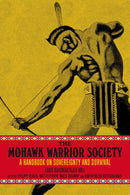Description
The first collection of its kind, this anthology by members of the Mohawk Warrior Society uncovers a hidden history and paints a bold portrait of the spectacular experience of Kanien'kehá:ka survival and self-defense. Providing extensive documentation, context, and analysis, the book features foundational writings by prolific visual artist and polemicist Louis Karoniaktajeh Hall (1918–1993)—such as his landmark 1979 pamphlet, The Warrior’s Handbook, as well as selections of his pioneering artwork. This book contains new oral history by key figures of the Rotisken'rhakéhte's revival in the 1970s, and tells the story of the Warriors’ famous flag, their armed occupation of Ganienkeh in 1974, and the role of their constitution, the Great Peace, in guiding their commitment to freedom and independence. We hear directly the story of how the Kanien'kehá:ka Longhouse became one the most militant resistance groups in North America, gaining international attention with the Oka Crisis of 1990. This auto-history of the Rotisken'rhakéhte is complemented by a Mohawk history timeline from colonization to the present, a glossary of Mohawk political philosophy, and a new map of Iroquoia in Mohawk language. At last, the Mohawk Warriors can tell their own story with their own voices, and to serve as an example and inspiration for future generations struggling against the environmental, cultural, and social devastation cast upon the modern world.
Louis Karoniaktajeh Hall (1918–1993) was a prolific Kanien'kehá:a painter and writer from Kahnawake, whose work continues to inspire generations of Indigenous people today. A man of all trades, Karoniaktajeh worked as a butcher, a carpenter, and a mason. Initially groomed for a life in the priesthood, Karoniaktajeh (on the edge of the sky) began his life as a devout Christian before later turning against what he saw as the fallacies of European religion, and deciding to reintegrate himself into the traditional Longhouse and help revive “the old ways.” Appointed as the Secretary of the Ganienkeh Council Fire, he became a prominent defender of Indigenous sovereignty, and was instrumental in the reconstitution of the Rotisken’rhakéhte (Mohawk Warrior Society). His distinctive artwork includes the iconic Unity Flag, which still symbolizes Indigenous pride across Turtle Island (North America). His legacy as a revivor and innovator of traditional Mohawk culture includes his works The Warrior’s Handbook (1979) and Rebuilding the Iroquois Confederacy (1980). Both these texts, which served during their time as a political and cultural call to arms for Indigenous communities across Turtle Island, were initially printed by hand and distributed in secret.
Philippe Blouin writes, translates and studies political anthropology and philosophy in Tionni’tio’tià:kon (Montreal). His current PhD research at McGill University seeks to understand and share the teachings of the Tehiohate (Two Row Wampum) to build decolonial alliances. He has published essays in Liaisons and Stasis, and an afterword to George Sorel’s Reflections on Violence.
Matt Peterson is an organizer at Woodbine, an experimental space in New York City. He is the co-director of The Native and the Refugee, a multi-media documentary project on American Indian reservations and Palestinian refugee camps.
Malek Rasamny co-directed the feature film Spaces of Exception and cofounded the multimedia research project The Native and the Refugee. He is currently completing a Master’s degree in the Science of Religions and Societies at the École des hautes études en sciences sociales in Paris.
Kahentinetha Rotiskarewake is a Kanien’kehá:ka from the Bear Clan in Kahnawà:ke. Initially working in the fashion industry, Kahentinetha went on to play a key role as speaker and writer in the Indigenous resistance, a role which she has fulfilled consistently for the last six decades. During this time she witnessed and took part in numerous struggles, including the blockade of the Akwesasne border crossing in 1968. She has published several books including Mohawk Warrior Three, and has been in charge of running the Mohawk Nation News service since the Oka Crisis in 1990. She now cares for her twenty children, grandchildren, and great-grandchildren. Kahentinetha means “she who is always at the forefront.”


